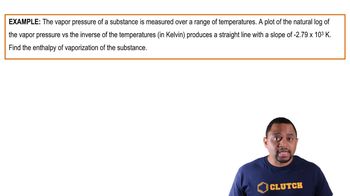Here are the essential concepts you must grasp in order to answer the question correctly.
Entropy
Entropy is a measure of the disorder or randomness in a system. In thermodynamics, it is often associated with the number of ways a system can be arranged. When a substance transitions from a liquid to a gas, such as bromine (Br2) boiling, the molecules move from a more ordered state to a less ordered state, leading to an increase in entropy.
Recommended video:
Entropy in Thermodynamics
Phase Change
A phase change refers to the transition of a substance from one state of matter to another, such as from liquid to gas during boiling. This process involves energy changes, specifically the enthalpy of vaporization, which is the energy required to convert a unit amount of a liquid into vapor at its boiling point. Understanding phase changes is crucial for analyzing changes in entropy.
Recommended video:
Enthalpy of Vaporization
The enthalpy of vaporization (ΔHvap) is the amount of energy required to convert one mole of a liquid into vapor at constant temperature and pressure. For bromine, this value is 29.6 kJ/mol. This energy input not only facilitates the phase change but also contributes to the increase in entropy, as the molecules in the gas phase have greater freedom of movement compared to those in the liquid phase.
Recommended video:
Enthalpy of Vaporization Example





